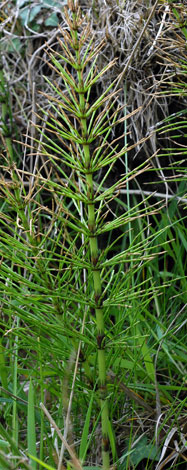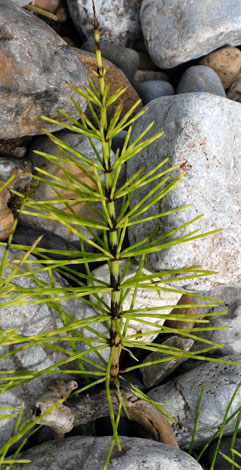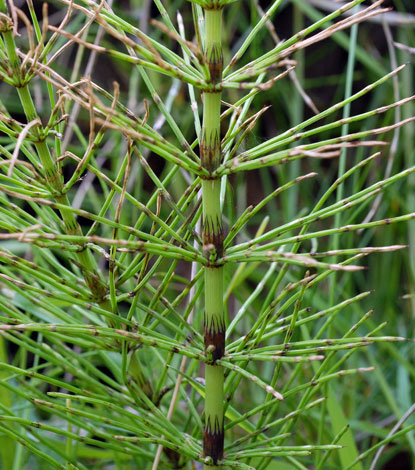Equisetum x robertsii Anglesey Horsetail (RRR) DD N Endemic



Officially this recently discovered hybrid between Equisetum arvense (Field Horsetail) and Equisetum telmateia (Great Horsetail) is only known from this one site on Anglesey and is new to science. It has been described in Watsonia 2004 (BSBI) and is present with both parents on exposed clay cliffs near the sea. In fact this bay is an excellent site for Horsetails. We found E. arvense (Field Horsetail), E. telmateia (Great Horsetail), E. palustre (Marsh Horsetail), E. x robertsii (telmateia x arvense) and E. x font-queri (telmateia x palustre) within a few hundred metres of each other. It is possible that the E. robertsii is actually all one plant as the visible structures above ground lead to a complex of interconnected rhizomes which, because of erosion are also conveniently displayed for inspection at this site.
E x robertsii has the wider, paler stem closer to E. telmateia but the cross section of the branches leans more towards the deep cross shape of E. arvense. It is nowhere near as tall as E. telmateia can be (over 1 m sometimes) and first impressions are that it looks like a peculiar E. arvense. The real surprise about his hybrid, now it has been shown to exist, is why there isn't more of it around. The two parents are common and do grow near to each other at many sites. Perhaps the reason is connected with habitat.
Horsetails have a similar life cycle to Ferns. They produce gametophytes which are green and live separately from the plant we know as the Horsetail. The gametophytes produce haploid (half the usual number of chromosomes) flagellated sperm. The sperm swim to the archegonium which is part of the same gametophyte structure, and down this "neck" to the haploid egg which is fertilised. The now diploid (full usual number of chromosomes for the species) young plant, called a sporophyte, begins to grow into a mature horsetail. It could be that hybridisation needs an open patch of ground such as that provided by these constantly eroding cliffs for the gametophytes to stick to, plus a wet habitat so the sperm can swim from the gametophyte of one parent towards the archegonium of different parent.
Of course there could be another reason - the site isn't too far from Anglesey's nuclear power station......
Research needed.
However my guess is that over the next few years more of this unique hybrid will be found. After all field botanists aren't exactly a common species themselves and those who can confidently identify horsetails never mind their hybrids are even fewer.
E x robertsii has been named after R. H. Roberts whose work on the Anglesey flora was much appreciated and respected in his lifetime. He was known for his work on orchids though so it's slightly ironic that famous for work on the most exotic and attractive of the world's plants he should have his name attached to one of the dullest.
Traeth Lligwy, Anglesey 29th June 2007
Added on 2nd July, updated January 2nd 2009, updated 29th March 2010



